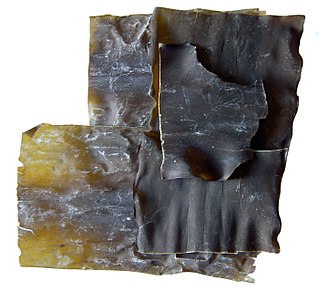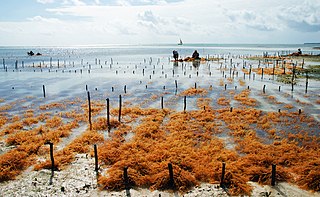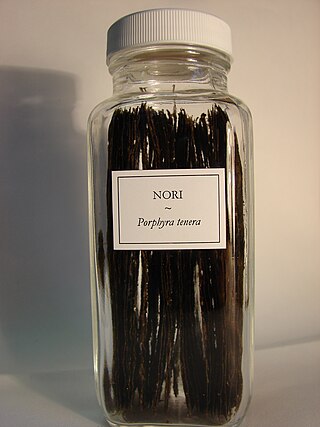
Nori(Japanese: 海苔) is a dried edible seaweed used in Japanese cuisine, usually made from species of the red algae genus Pyropia, including P. yezoensis and P. tenera. It has a strong and distinctive flavor, and is generally made into flat sheets and used to wrap rolls of sushi or onigiri.

Konbu is edible kelp mostly from the family Laminariaceae and is widely eaten in East Asia. It may also be referred to as dasima or haidai.

Palmaria palmata, also called dulse, dillisk or dilsk, red dulse, sea lettuce flakes, or creathnach, is a red alga (Rhodophyta) previously referred to as Rhodymenia palmata. It grows on the northern coasts of the Atlantic and Pacific Oceans. It is a well-known snack food. In Iceland, where it is known as söl, it has been an important source of dietary fiber throughout the centuries.

Green laver, known as aonori in Japan, sea cabbage (海白菜) or hutai (滸苔) in China, and parae (파래) in Korean, is a type of edible green seaweed, including species from the genera Monostroma and Ulva. It is commercially cultivated in some bay areas in Japan, Korea, and Taiwan, such as Ise Bay. It is rich in minerals such as calcium, magnesium, lithium, vitamins, and amino acids such as methionine. It is also called aosa in some places in Japan.
Pyropia columbina, Southern laver, karengo in the Māori language and luche in the Spanish language, is a species of edible seaweed traditionally harvested by South Island Māori in New Zealand and Chilote people in Chile. It is closely related to Japanese Nori and Welsh laverbread.

Algaculture is a form of aquaculture involving the farming of species of algae.

Porphyra is a genus of coldwater seaweeds that grow in cold, shallow seawater. More specifically, it belongs to red algae phylum of laver species, comprising approximately 70 species. It grows in the intertidal zone, typically between the upper intertidal zone and the splash zone in cold waters of temperate oceans. In East Asia, it is used to produce the sea vegetable products nori and gim. There are considered to be 60–70 species of Porphyra worldwide and seven around Britain and Ireland, where it has been traditionally used to produce edible sea vegetables on the Irish Sea coast. The species Porphyra purpurea has one of the largest plastid genomes known, with 251 genes.
Culinary names, menu names, or kitchen names are names of foods used in the preparation or selling of food, as opposed to their names in agriculture or in scientific nomenclature. The menu name may even be different from the kitchen name. For example, from the 19th until the mid-20th century, many restaurant menus were written in French and not in the local language.

A full breakfast is a substantial cooked breakfast meal, often served in Great Britain and Ireland. The typical ingredients are bacon, sausages, eggs, black pudding, baked beans, tomatoes, mushrooms and fried bread with toast and a beverage such as coffee or tea served on the side. Hash browns are a common contemporary but non-traditional inclusion. Ingredients may extend beyond these or include regional variants, which may often be referred to by different names depending on the area. While it is colloquially known as a "fry-up" in most areas of the United Kingdom and Ireland, it is usually referred to as a "full English", a "full Irish", "full Scottish", "full Welsh", and "Ulster fry", in England, the Republic of Ireland, Scotland, Wales, and Northern Ireland, respectively.

Laverbread is a food product made from laver, an edible seaweed consumed mainly in Wales as part of local traditional cuisine. The seaweed is commonly found around the west coast of Great Britain, and the coasts of Ireland, where it is known as sleabhac. It is smooth in texture and forms delicate, sheetlike thalli, often clinging to rocks. The principal variety is Porphyra umbilicalis, a red algae which tends to be a brownish colour, but boils down to a dark green pulp when prepared. Laver seaweed has a high content of dietary minerals, particularly iodine and iron. The high iodine content gives the seaweed a distinctive flavour in common with olives and oysters.

Gim (Korean: 김), also romanized as kim, is a generic term for a group of edible seaweeds dried to be used as an ingredient in Korean cuisine, consisting of various species in the genera Pyropia and Porphyra, including P. tenera, P. yezoensis, P. suborbiculata, P. pseudolinearis, P. dentata, and P. seriata.

Seaweed, or macroalgae, refers to thousands of species of macroscopic, multicellular, marine algae. The term includes some types of Rhodophyta (red), Phaeophyta (brown) and Chlorophyta (green) macroalgae. Seaweed species such as kelps provide essential nursery habitat for fisheries and other marine species and thus protect food sources; other species, such as planktonic algae, play a vital role in capturing carbon and producing at least 50% of Earth's oxygen.

Red algae, or Rhodophyta, make up one of the oldest groups of eukaryotic algae. The Rhodophyta comprises one of the largest phyla of algae, containing over 7,000 recognized species within over 900 genera amidst ongoing taxonomic revisions. The majority of species (6,793) are Florideophyceae, and mostly consist of multicellular, marine algae, including many notable seaweeds. Red algae are abundant in marine habitats. Approximately 5% of red algae species occur in freshwater environments, with greater concentrations in warmer areas. Except for two coastal cave dwelling species in the asexual class Cyanidiophyceae, no terrestrial species exist, which may be due to an evolutionary bottleneck in which the last common ancestor lost about 25% of its core genes and much of its evolutionary plasticity.

Edible seaweed, or sea vegetables, are seaweeds that can be eaten and used for culinary purposes. They typically contain high amounts of fiber. They may belong to one of several groups of multicellular algae: the red algae, green algae, and brown algae. Seaweeds are also harvested or cultivated for the extraction of polysaccharides such as alginate, agar and carrageenan, gelatinous substances collectively known as hydrocolloids or phycocolloids. Hydrocolloids have attained commercial significance, especially in food production as food additives. The food industry exploits the gelling, water-retention, emulsifying and other physical properties of these hydrocolloids.

Kathleen Mary Drew-Baker was an English phycologist. She was known for her research on the edible seaweed Porphyra umbilicalis (nori), which led to a breakthrough for commercial cultivation.

Gamet is a traditional dried edible seaweed from Ilocos Norte and Cagayan of the Philippines, particularly from the town of Burgos. Gamet are dried into sheets or thin cakes called pedazo, which are characteristically purplish-black in color. It is used widely in soups, salads, omelets and other dishes, in the cuisines of the northern Philippines.

Bangiales is an order of multicellular red algae of the class Bangiophyceae containing the families Bangiaceae, Granufilaceae, and possibly the extinct genus Rafatazmia with one species, Rafatazmia chitrakootensis. They are one of the oldest eukaryotic organisms, possibly dating back to 1.6 billion years old. Many species are used today as food in different cultures worldwide. Their sizes range from microscopic (Bangiomorpha) to up to two meters long. Many of its species are affected by Pythium porphyrae, a parasitic oomycete. Similar to many other species of red algae, they reproduce both asexually and sexually. They can be both filamentous or foliose, and are found worldwide.

Pyropia tenera, also known as gim or nori, is a red algal species in the genus Pyropia. The specific name, tenera, means "delicate" and alludes to its small size. It typically grows to lengths between 20 and 50 cm. It is most typically found in the western Pacific Ocean and the Indian Ocean.

Welsh cuisine encompasses the cooking styles, traditions and recipes associated with Wales. While there are many dishes that can be considered Welsh due to their ingredients and/or history, dishes such as cawl, Welsh rarebit, laverbread, Welsh cakes, bara brith and Glamorgan sausage have all been regarded as symbols of Welsh food. Some variation in dishes exists across the country, with notable differences existing in the Gower Peninsula, a historically isolated rural area which developed self-sufficiency in food production.

















